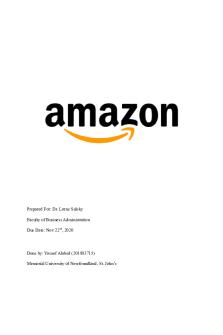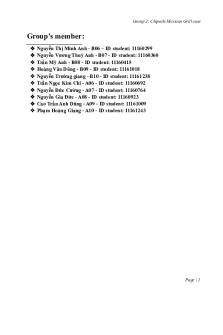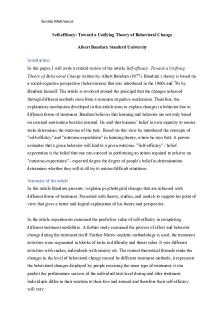Coles - Individual Assignment Modified PDF

| Title | Coles - Individual Assignment Modified |
|---|---|
| Author | Salai Rajan |
| Course | Strategic Frameworks |
| Institution | Macquarie University |
| Pages | 13 |
| File Size | 456.9 KB |
| File Type | |
| Total Downloads | 18 |
| Total Views | 170 |
Summary
Download Coles - Individual Assignment Modified PDF
Description
Individual Assignment
Coles Group Limited Performance Measurement and Management system analysis
Table of Contents
1. 2. 2.1 2.2 2.3 3. 3.1 3.2 4.
Introduction........................................................................................................................................................... 2 Company’s overview....................................................................................................................................... 2 Vision, Purpose and Strategy.................................................................................................................... 4 Value Chain and Value Creation.............................................................................................................. 6 Competitive Strategy....................................................................................................................................... 8 External Analysis............................................................................................................................................... 8 Porter’s Five Forces........................................................................................................................................ 9 PESTEL Analysis............................................................................................................................................ 10 Conclusion.......................................................................................................................................................... 11
1. Introduction In order to improve business performance and productivity by reducing cost it is important to align activities with strategy through the implementation of performance measurement system. The main aim of this report is to develop a Business Performance Measuring System (Balanced Scorecard) for Coles Group Limited (COL). Coles is considered the second largest supermarket in Australia with 29.1% market shares. This report will present COL’s overview and external analysis in order to identify value drivers. Following by COL’s financial performance analysis, which will help to identify alignment between value drivers in the previous section and company metrics. Finally, the results are used to develop a strategy map and a balance scorecard for COL.
2. Company’s overview
2
Coles Group Limited was incorporated on July 1921 after 7 years of the first Coles variety store opening in 1914 in Collingwood, Victoria by George Coles and is listed on the Australian Securities Exchange under the code COL from 2018. Currently, Coles is considered as one of the Australia's largest retailers with a market capitalization of $20.6 billon, more than 2,400 stores throughout Australia, and over 113,000 employees across its supermarkets, liquor stores, convenience outlets and hotels and financial services (Annual Report 2019). According to Figure 1, supermarkets are the highest contributors to COL’s revenue with 79.8%, following by Coles Express (10.2%) and liquor stores (8.2%). For this reason, the company lies into the category G4111 – Supermarkets and Grocery Stores in Australia, in which occupies the second position by holding 29.1% of the domestic market share (Figure
2)
(IBISWorld,
2020).
Figure 1. COL’s Operating Divisions – Revenue (Source: IBISWorld 2019)
3
Figure 2. Major Player Australian Supermarkets Industry (Source: IBISWorld 2020)
In FY19, Coles Group Limited registered sales of $38.2 billion, which were down from 2018 by 1.9%, EBIT reduced by 0.9% to $1.5 billion and NPAT was up by 5.4% to $1.1 billions. The overall reduction in sales revenue and EBIT is due to lower sales revenue in Express (-30.6%) driven by a decline in fuel volumes and the move to a commission agent mode under the New Alliance Agreement. However, Supermarkets and Liquor revenue grew by 3.2% and 0.8% respectively as a result of price-discounting strategy. Earnings per share (EPS) increased by 5.3% to 80.8 cents per share and the total dividend for FY19 was 35.5 cents per share. In terms of customer satisfaction in supermarket, it reached 87.7% (Annual Report, 2020).
2.1 Vision, Purpose and Strategy Coles’ vision is “ Become the most trusted retailer in Australia and grow long-term shareholder value” (Annual Report 2019). For Coles, trust is primarily about being reliable, responsible and sustainable. As a food provider their high responsibility is addressed by offering products that have been sourced responsibly and ethically without compromising on food safety, quality or nutrition.
4
Coles’ purpose is “Sustainably feed all Australians to help them lead healthier, happier lives” (Annual Report 2019). From food waste to a sustainable food chain, they want to be sure their long existence, creating jobs, supporting their suppliers and making a positive difference in their local communities. Coles’ strategy, sowed in Figure 3, consists in three pillars, which must be interrelated
Inspiring Customers through best-value food and drink solution to make lives easier. This reflects a customer centric and low cost strategy.
Smarter selling through efficiency and pace of change in order to become more agile. This pillar suggests the importance of investing in technology in order to be more efficient.
Winning together with their team members, suppliers and communities in a sustainable manner, which is considering people as a fundamental part for the success of the business and talk about sustainability as broader than environmental management.
5
Figure 3. Coles’ Strategy (Source: Annual Report 2019)
2.2 Value Chain and Value Creation Coles’ value chain is showed in Figure 4, which indicates the main activities that Coles carries in order to create value to customers.
6
Figure 4. Coles’ value-chain (Source: Own Design)
Considering customer journey analysis (Figure 5) it is found that Technology and Operations areas have the strongest impact on customer experience. Figure 5. Coles’ customer journey (Source: Own Design)
Coles is driven by its cost leadership strategy, which allows them to offer products at the lowest prices afforded by the company due to its core competences in supply chain 7
(operation) and management information system (Technology) which allows an efficient and effective control of inventories. Coles is ensuring to offers value to its customers at the lowest possible costs.
2.3 Competitive Strategy Coles innovates business model to improve their competitiveness. As they have been driven by cost leadership strategy, many well-known brands have been replaced by Coles’ own home brands. This will promote the increase of profit and reduce the distance with the competitors. Additionally, multi-business models development, such as ECommerce website, Mobile Applications also extend the competitive advantage.
3. External Analysis
Figure 6. Supermarkets Industry at a Glance (Source: IBISWorld 2020)
According to Figure 6, Australian Supermarket and Grocery store market has grown at the rate of 2.2% over the last five years (2015 to 2020), reaching total revenue of $113.3 billion in 2020 and is expected to continue that growth annually rate for the next five years (IBISWorld 2020).
3.1 Porter’s Five Forces
8
Five Forces Model (Figure 7) rates market’s attractiveness in a medium to high level, resulting in high profit potential. The area in which should be considered more attention is the highly competitiveness in the market.
Competitive Rivalry
Supplier Power
High Medium
Competition on the basis of Price and product differentiation (customer services and innovation)
Low
Few number of major competitors: Woolworths 37.6% Aldi 9.9% High number of suppliers Product supplied are fairly standardised Low switching costs High product differentiation, which means buyers are not able to find alternatives firms producing a particular product
Buyer Power
Low
Threat of Substitution Threat of New Entry
Low
Low
Buyers with low income are more price sensitive Buyers who prefer quality are less price sensitive
Few substitutes with higher quality products which are much more expensive.
High barrier to entry in the industry: - High costs of establishment - High investment - Dominance of major players
Figure 7. Five Forces (Source: Own Design)
3.2 PESTEL Analysis
9
PESTEL Analysis (Figure 8) proposes that the market can offer larger opportunities than threats, making it attractive with high profit potential . Opportunities Government support
Threats P Political
* Stable, low-growth mature business * The rate of GDP growth
* Economical recession E Economical
* High level of unemployment --> Lower wages, lowers costs * Support to improve cancer care for children and young * Social conscious -Sustainably feed all Australians to help them lead healthier, happier lives * Address food insecurity (meals donation)
Government regulations
S Social
* Lower prices in Competitor such as ALDI * High level of unemployment --> Low spending Australia Customers
Rapidly changes in customer preferences
* Increased used of internet by customers * Contactless payment, self check out facilities Internet based e-commerce T * Smart Selling - which help to cut Technological websites (like Amazon) costs * The use of new systems to optimize operation and generate a better customer service * Use of sustainable products Weather conditions --> Poor E * Eco-friendly Supermarkets Environmental supply of food * Sustainable strategy L Legal
Legal action of ACCC against Coles
Figure 8. PESTEL Analysis (Source: Own Design)
10
Figure 1&. Proposed Balance Scorecard (Source: OWN Design)
4. Conclusion Coles’ primacies are supported by its financials, value-chain and customer loyalty. Coles’ main objective is to increase shareholders value, which can be done through focusing its efforts to build a sustainable operating model with high-tech investments referring to its Smarter selling pillar in their strategy. The high effort in technology implementation will be reflected in offering low prices with high quality and in a superior customer experience, which are fundamental to maintain their positioning in a highly competitive environment. All of this benefits leads to revenues growth.
It is recommended that Coles ensures the alignment of the measurements with the overall strategy by monitoring them constantly and adapting when it is required in order to 11
optimize the use and relevance of these KPIs. These align employees within company vision, mission, objectives and strategy. The combination of leading and lagging indicators will highlight progress towards the company strategy.
References 12
DatAnalysis Premiun Data Base. Viewed 30 May 2020,
COL’s Annual Report 2019
CSI
Market
website,
viewed
3
June
2020,
Finance Yahoo website, viewed 2 June 2020,
13...
Similar Free PDFs

Modified - assignment
- 21 Pages

Coles - read
- 4 Pages

Individual Assignment
- 26 Pages

Individual Assignment
- 20 Pages

Individual assignment
- 5 Pages

Individual assignment
- 3 Pages

MGT 162 INDIVIDUAL ASSIGNMENT
- 24 Pages

finance - individual assignment
- 7 Pages

Mkt individual assignment
- 4 Pages

BUS assignment individual
- 7 Pages
Popular Institutions
- Tinajero National High School - Annex
- Politeknik Caltex Riau
- Yokohama City University
- SGT University
- University of Al-Qadisiyah
- Divine Word College of Vigan
- Techniek College Rotterdam
- Universidade de Santiago
- Universiti Teknologi MARA Cawangan Johor Kampus Pasir Gudang
- Poltekkes Kemenkes Yogyakarta
- Baguio City National High School
- Colegio san marcos
- preparatoria uno
- Centro de Bachillerato Tecnológico Industrial y de Servicios No. 107
- Dalian Maritime University
- Quang Trung Secondary School
- Colegio Tecnológico en Informática
- Corporación Regional de Educación Superior
- Grupo CEDVA
- Dar Al Uloom University
- Centro de Estudios Preuniversitarios de la Universidad Nacional de Ingeniería
- 上智大学
- Aakash International School, Nuna Majara
- San Felipe Neri Catholic School
- Kang Chiao International School - New Taipei City
- Misamis Occidental National High School
- Institución Educativa Escuela Normal Juan Ladrilleros
- Kolehiyo ng Pantukan
- Batanes State College
- Instituto Continental
- Sekolah Menengah Kejuruan Kesehatan Kaltara (Tarakan)
- Colegio de La Inmaculada Concepcion - Cebu





